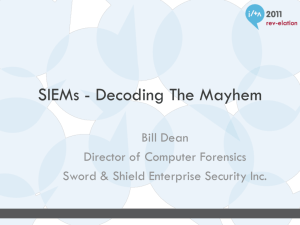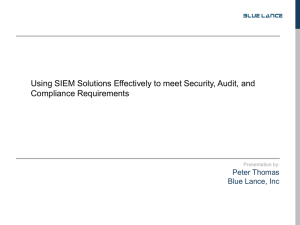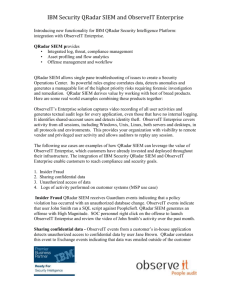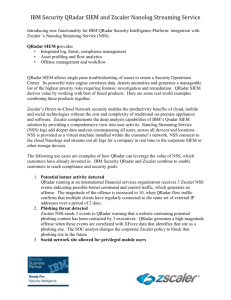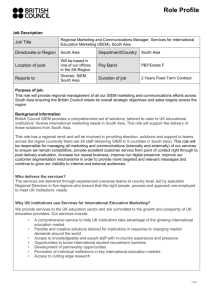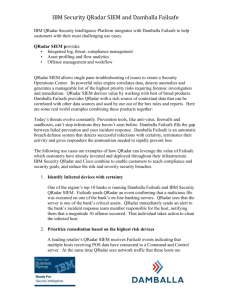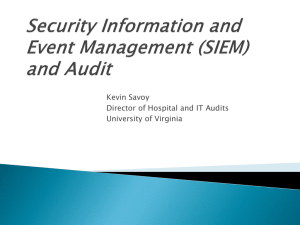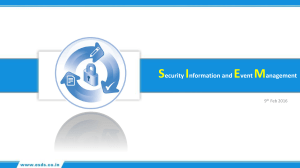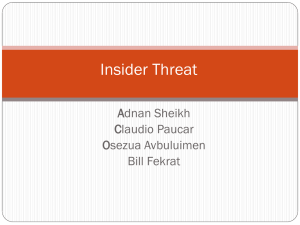SIEM Based Intrusion Detection
advertisement
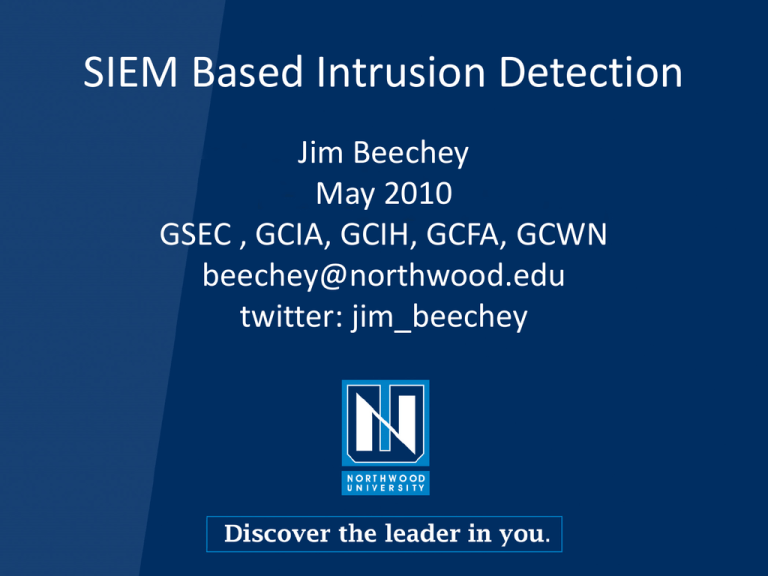
SIEM Based Intrusion Detection Jim Beechey May 2010 GSEC , GCIA, GCIH, GCFA, GCWN beechey@northwood.edu twitter: jim_beechey Objective • Attackers are more sophisticated and targeted in their attacks. • Defenders need systems which help provide visibility and altering across numerous security systems. • SIEM adoption driven by compliance • Gartner says “more than 80%” • Put “Security” back into SIEM using real world examples. 2 SIEM System Setup 3 Basics – Outbound Traffic • Outbound SMTP, DNS and IRC • Unexpected outbound connections 4 New Hosts and Services • Scanner integration for new host and service discovery 5 Darknets • Network segments without any live systems, but are monitored • Any traffic considered suspicious • Qradar defines Darknets at setup • Qradar Rule: Suspicious Activity: Communication with Known Watched Networks 6 Brute-force Attacks • Create reports to generate statistical data on failed logins by device, source IP and locked accounts per day. • Qradar provides several alerts for brute force attacks. Login Failures Followed by Success and Repeated Login Failures Single Host being the most helpful • Customize alerts for maximum impact 7 Brute-force Attacks 8 Windows Accounts • Report of accounts created by whom • Alerts for: – accounts not using std naming convention – outside of creation script timeframe – workstation account created – group membership adds to key groups • Understand the account management process and alert accordingly 9 IDS Context/Correlation • Reduce noise by reporting based upon high value systems or asset weights • Add context of target operating system • Add knowledge of vulnerabilities • Rules • Target Vulnerable to Detected Exploit • Vulnerable to Detected Exploit on Different Port • Vulnerable to Different Exploit than Detected on Attacked Port 10 Web Application Attacks • Analyze WAF logs if possible as header data (POST) not available in server logs • Create regular expressions to look for signs of attack, for example • /(\%27)|(\')|(\-\-)|(\%23)|(#)/ix – Detects ‘ or -- • Create and alert on web honeytokens • Fake admin page in robots.txt • Fake credentials in html code 11 Data Exfiltration • Collection of flows or session data is extremely helpful • Reports/Alerts based upon – Size/destination of outbound flows “Large Outbound Data Transfer” – Application data inside specific protocols – Frequency of requests/application usage – Session Duration “Long Duration Flow” 12 Client Side Attacks • Information in Windows event logs: – Process Information • Start (592/4688) Ends (593/4689) – New Service Installed (601/4697) – Scheduled Tasks Created (602/4689) – Audit Policy Changed and Cleared • (612/4719) and (517/1102) • Integration with third-party tools 13 Sample Attack 14 Summary • Defenders need to look for indicators of compromise across many sources • SIEM solution centralize data • Start small with basic methods, test, and move to more advanced techniques • Goal is to detect compromise and provide as much information as possible before starting incident response 15 System Options • Commercial SIEM Solutions – ArcSight (www.arcsight.com) – Q1Labs Qradar (www.q1labs.com) – RSA Envision (www.rsa.com) • Lower Cost/Free Log Search –Q1Labs FE (www.q1labs.com) –OSSEC (www.ossec.net) –Splunk (www.splunk.com)
